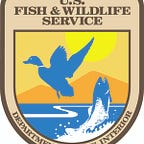Fish Eye View
Three Things Our Fav Fish Photographer Wants You to Know
Plus his top pics, tips and tricks for camera nerds
As told to Amanda Smith, USFWS Columbia Pacific NW Region, External Affairs
Roger Tabor is a USFWS fisheries biologist in Lacey, Washington and he has a penchant for photography. His love for conserving fish and aquatic species is matched only by his love of capturing them on camera. Roger’s passion for snapping photos preceded his profession and here he shares his favorite tips and pics from the past four decades.
What got you into taking photos of nature, specifically aquatic species?
I started taking pictures when I worked in the backcountry of the mountains of Colorado. When I moved to this office (Western Washington Fish & Wildlife Office), I started working on a few projects that involved snorkeling and got hooked on taking underwater photos of aquatic life. I found it was not only enjoyable but also a valuable part of my work. I started with a Nikonos V film camera but was always limited by the expense of buying and processing film and the small number (24 or 36) of exposures on a roll of film. About 12 years ago, I switched over to digital cameras which has helped me considerably.
What would be your dream species/place to photograph or what is on your bucket list in terms of photography?
In the past few years, I have been fortunate enough to visit a few spots on my wish list. I was able to go on a three-day backpacking trip to visit a mountain lake that has the only remaining population of Arctic grayling in Washington State (originally stocked in the 1947). Also, I was lucky enough to get some photos of spawning peamouth in Abernathy Creek thanks to the help of Abernathy Fish Technology Center and this is a rare sight. I have lots of fish and invertebrates on my wish list but would particularly like to get to some Midwest or Southeast streams to see some of the colorful darters.
What advice do you have for people looking to become more serious about nature photography?
Underwater photography is quite different than other nature photography and I have a few initial thoughts. 1) Get close — It’s important to get as close to your subject as possible to reduce the amount of water between you and the subject. For me, the hardest thing is to be patient and slowly get close enough to take a good photo. 2) Clear water sites — An important element of underwater photography is to try and pick a spot with clear water. Sites with clearer water will always be better. Where I live, I’m fortunate to have a few nearby springs and those spots are my favorites for taking pictures. And 3) take lots of photos — With underwater photography there are lots of ways to take a bad picture (out of focus, poor lighting, subject moved, backscatter, etc.) and I’ve probably done them all, so it’s important to take lots of photos.
Share some of your favorite photos with us and how you got the shot!
For more of Roger Tabor’s photography, check out this Flickr album of his work.
